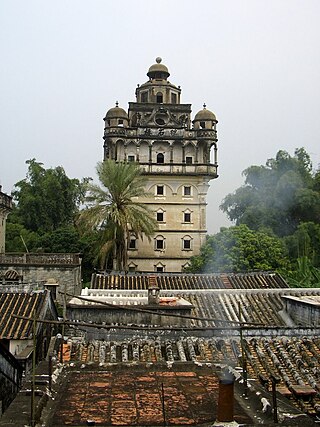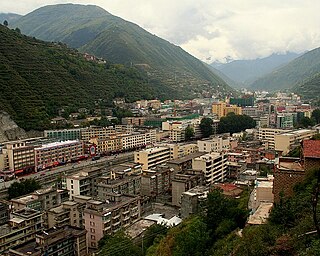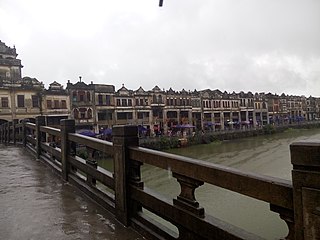
Yongding is a district under the jurisdiction of Longyan prefecture-level city in the southwest of Fujian Province, People's Republic of China. The district is a center for Hakka culture, including the traditional Hakka tulou, and a local dialect of the Hakka Chinese called the Yongding Dialect. As of 2015, Yongding has a permanent population of about 361,000, of which more than 99% are Hakka, the rest being She people. In December 2014, the Fujian government signed legislation converting Yongding from a county to a district.

A Hakka walled village is a large multi-family communal living structure that is designed to be easily defensible. This building style is unique to the Hakka people found in southern China. Walled villages are typically designed for defensive purposes and consist of one entrance and no windows at the ground level.

Kaiping, alternately romanized in Cantonese as Hoiping, in local dialect as Hoihen, is a county-level city in Guangdong Province, China. It is located in the western section of the Pearl River Delta and administered as part of the prefecture-level city of Jiangmen. The surrounding area, especially Sze Yup, is the ancestral homeland of many overseas Chinese, particularly in the United States. Kaiping has a population of 688,242 as of 2017 and an area of 1,659 square kilometres (641 sq mi). The locals speak a variant of the Sze Yup dialect.
Ethnic townships, ethnic towns, and ethnic sums are fourth-level administrative units designated for ethnic minorities of political divisions in the People's Republic of China. They are not considered to be autonomous and do not enjoy the laws pertaining to the larger ethnic autonomous areas such as autonomous regions, autonomous prefectures, autonomous counties, and autonomous banners.

Diaolou are fortified multi-storey watchtowers in rural villages, generally made of reinforced concrete. These towers are located mainly in Kaiping, Guangdong province, China. In 2007, UNESCO designated the Kaiping Diaolou and Villages (开平碉楼与村落) a World Heritage Site, which covers four separate Kaiping village areas: Sanmenli (三门里), Zilicun (自力村), Jinjiangli (锦江里), and Majianglong village cluster (马降龙村落群). These areas demonstrate a unique fusion of 19th- and 20th-century Chinese and Western architectural styles.

Zhangpu County is a county of Zhangzhou prefecture-level city in far southern Fujian province, People's Republic of China. The county seat is located in the town of Sui'an (绥安镇).

The Fujiantulou are Chinese rural dwellings unique to the Hakka in the mountainous areas in southeastern Fujian, China. They were mostly built between the 12th and the 20th centuries.

The Chuxi Tulou cluster is a group of earthen structures or "tulou" dating to the Ming dynasty (1368–1644). The group provides a tourist attraction in the town of Xiayang (下洋镇), Yongding County, Longyan, Fujian Province, China.

Barkam or Markang or Muerkvua is a county-level city in Ngawa Tibetan and Qiang Autonomous Prefecture, in the northwest of Sichuan province, China. The city seat is the town of Barkam. As of the 2010 Chinese Census, Barkam has a population of 58,437.

Fengnan District is a district of Tangshan, Hebei, China on the coast of the Bohai Sea and bordering Tianjin to the west. The district spans an area of 1,305.19 square kilometres (503.94 sq mi), and has a population of approximately 530,000 as of 2012.
The Wuhua dialect is a major dialect of Hakka Chinese spoken in Wuhua County, Jiexi County, Shenzhen, eastern Dongguan, Northern Guangdong around Shaoguan, Sichuan Province, and Tonggu County in Jiangxi Province.

Tuojiang Town is an ancient town and the seat of Fenghuang County in Hunan, China. It has an area of 191.7 km2 (74.0 sq mi) with a population of 112,200. The town has 29 villages and 7 communities under its jurisdiction, its seat is at Fenghuang South Road. The town is famous for Ancient City of Fenghuang, it is one of the most important tourist destinations in Hunan and one of AAAA-rated tourist attractions.

Chikan is a town in Kaiping (開平), Jiangmen, Guangdong Province, China. It is officially designated as a National Historic and Cultural Town of China (中国历史文化名镇). Historically it was a regional maritime hub, center for emigration, emigrant market town, and the administrative centre of Kaiping.


















